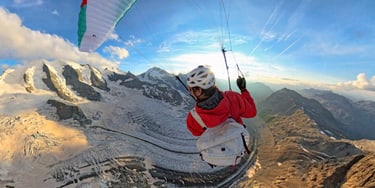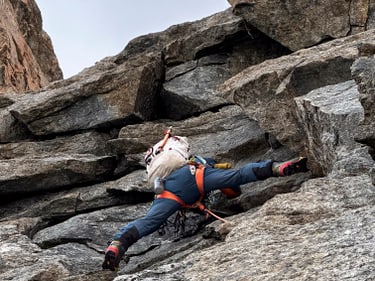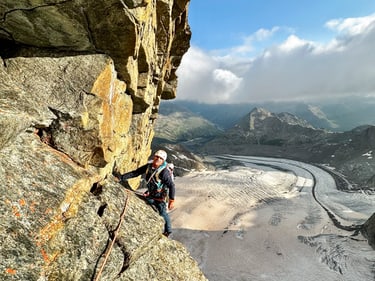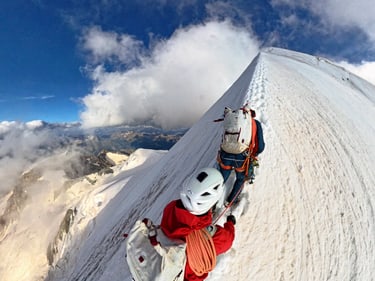A Conversation with Roger Schäli on the Palü Trilogy
In August 2024, Roger Schäli and Romano Salis successfully completed the ascent of all three Palü pillars in the Bernina Massif using "Climb & Fly." In the interview, Roger shares personal insights into the preparation, equipment, and execution of the trilogy. The Icefall backpack from EXPED accompanied him - so we were curious about his feedback on the model.

EXPED: The three Palü pillars in 16 hours, congratulations! How did you come up with this project?
Roger Schäli: When you’re often around the Palü and the Bernina Massif and see the three pillars - it’s just such an amazing natural setup—the idea naturally comes to mind. Climbing three towers at once is really motivating and makes sense. Adding a light glider makes the project quite obvious.
Did you stick to your timeline, or did you aim to be even faster?
We didn’t have a set timeline. We actually wanted to be faster, but conditions on the Middle Pillar, also called Bumiller Pillar, and the West Pillar were tough; it was quite bare. We considered how to get out, but downclimbing was difficult, so we chose to push up. When we got to the top, we still had enough time and, most importantly, daylight, and our plan ultimately worked out. But we had thought that in optimal conditions, we might be able to finish 2 or 3 hours faster.
You must have prepared well - are there things you can’t really prepare for?
With the paraglider, the wind is always an unpredictable factor. In mountaineering, you can somewhat ignore the wind. In paragliding, however, you can’t fully control it; it might be too strong or come from the wrong direction. You need favorable conditions to take off from the summit and land at 3,000 meters.
Our plan also required two people who could commit time spontaneously whenever conditions and weather were favorable. It’s a smaller-scale focus compared to a long expedition; your daily life has to allow for spontaneous action, like saying, “Okay, tomorrow’s the day.” This was our first attempt, and it worked out right away. The weather was worse than expected at the beginning of the day, wetter than we thought, and the start was windier. At the second pillar, we noticed it was very bare, making it feel like walking on eggs through loose rocks. There were essentially no intermediate belays, which made for some precarious climbing.
I should mention that mountaineer and photographer Robert Bösch climbed the three pillars solo many years ago in certainly incomparable conditions.
Did anything go surprisingly well?
Roger Schäli: After the second pillar, we had a bit of a low point, but there was enough energy and motivation because the weather kept improving. The end went surprisingly well. The last pillar is the most frequently climbed and is accordingly well-equipped. This order of tackling the pillars proved to be the right choice.
In the Alps, we focus on light gear for day tours. You always have to expect thunderstorms in summer, and we would only have had a chance to retreat every three to four hours at best.
How do you reconcile different disciplines when it comes to equipment? What does the equipment need to do?
In the Alps, we focus on light gear for day tours. You always have to expect thunderstorms in summer, and we would only have had a chance to retreat every three to four hours at best. Rescues aren’t always possible and are especially challenging in this terrain, so we were aware of that. You could say we were traveling light with optimism. It’s not comparable to the gear needed for a north face climb with bivouac and extra layers. We didn’t bring an emergency parachute - only a paraglider with a 100-gram Dyneema harness. The focus was on being lightweight: one liter of water, a few energy bars.
Would you do anything differently next time?
We originally wanted to do the project in the spring with more snow. The second pillar would have been easier to tackle with more snow, and we might have saved some time.
And regarding the equipment?
Everything worked well. Our experience was very important - we know the area well, which is also a form of equipment.
What was the most valuable element for you in this project?
Always important: keep a sense of humor. It’s essential not to let the mood drop in tense situations. Self-irony helps a lot.
We had a little joker: Romano’s father watched us with binoculars at the second pillar, and we talked on the phone, finding a hook he had placed during a previous ascent.
Have you already planned your next project?
We have many ideas! Romano is already focusing semi-professionally on flying. For the next projects, we’re considering whether flying will be “just” a descent or if we’ll need to cover distances - this adds another layer of complexity. At the Palü, we used very small gliders, which can make landing a challenge.
What do you like best about the EXPED Icefall?
The backpack is super robust. We could even haul it while climbing, and it held up well. You can tell it’s really made for extreme use. Plus, it’s lightweight and has generous capacity (50 liters). Thanks to the roll-top, you can still compact it down. The large side zipper is also great, giving quick access to the water bottle.
Higher, faster, further - is that your thing? Or was it more about the technical challenge of the routes?
For us, it was more of an aesthetic project. The three pillars simply stand out as a unit - they seem magically shaped by nature. The trilogy has been done twice before, but we added the flying element. I see it as a logical progression to test what the equipment can do. This way, tours gain a new dynamic.


